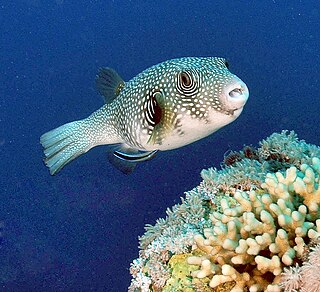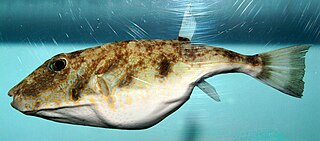
The white-spotted puffer fish is a medium to large-sized puffer fish, it can reach 50 cm length. It is light grey in color, or greyish or yellowish, and clearly covered with more or less regular white points, that become concentric contrasting white and dark grey lines that radiate around the eyes and pectoral fins. The ventral part is white. The "shoulder" is dark. It also has concentric contrasting white and dark grey lines that radiate around the eyes and pectoral fins. The white spotted puffer fish is poisonous.

Sphoeroides is a genus of pufferfishes.

The blunthead puffer is a pufferfish of the family Tetraodontidae, found circumglobally in tropical and temperate seas, at depths between 50 and 500 m. First recorded in the Mediterranean Sea off the Spanish coast in 1981, after entry via the strait of Gibraltar, it invaded the western basin in following decades and now reaches eastward the Adriatic Sea, the Aegean Sea and Levantine waters. Its length is up to 40 cm. It is an edible species, and is commonly eaten in Japan, where it is referred to as 'yorito fugu', and has a lower concentration of tetrodotoxin compared to other species of pufferfish prepared and eaten as fugu, but caution is needed as its liver contains dangerous levels of the toxin, and must not be eaten.
The spiny blaasop is a species of pufferfish. Originally native to the Indian Ocean, the southwestern Pacific Ocean and the Atlantic Ocean along the coast of South Africa, it has recently colonised the Levantine waters of the Mediterranean Sea, most likely as a Lessepsian migrant from the Red Sea or in ballast water. This species grows to a length of 5–15 cm. It is the only species in its genus.

Cephalopholis taeniops, the African hind, bluespotted sea bass or spotted grouper, is a species of marine ray-finned fish, a grouper from the subfamily Epinephelinae which is in the family Serranidae which also includes the anthias and sea basses. This species occasionally makes its way into the aquarium trade and is a target for local fisheries. It is found in the eastern Atlantic Ocean.

The so-iuy mullet, also known as the haarder, redlip mullet or so-iny mullet, is a species of fish in the family Mugilidae.

The tasseled blenny is a species of combtooth blenny native to the Indo-West Pacific. A single specimen was reported in 2013 in the Mediterranean Sea off Antalya, Turkey. This species reaches a length of 6.2 centimetres (2.4 in) TL.
Seriola carpenteri is a species of bony fish commonly known as the Guinean amberjack, which feeds on squids and fishes. It attains a size of at least 48 cm fork length, and probably attains a much larger size. Adults are pelagic or epibenthic. Generally confined to areas where surface temperatures exceed 25 °C, the species is found in coastal waters over continental shelf from the surface to at least 200 m deep.

Cryptocentrus caeruleopunctatus, commonly known as the harlequin prawn-goby, is a species of goby. It recently entered the Mediterranean Sea with large populations observed along the Israel coast. Before its recording in the Mediterranean this species was restricted to the Red Sea where it occurs on open sand bottoms of clear water reefs living in association with alpheid shrimps.

Lagocephalus sceleratus, commonly known as the silver-cheeked toadfish, or Sennin-fugu, is an extremely poisonous marine bony fish in the family Tetraodontidae.
The João Lopes Bank is a seamount situated 1 nautical mile (1.9 km) northwest of the community of Anjos, on the Portuguese island of Santa Maria in the Azores.

Holacanthus africanus, the Guinean angelfish or West African angelfish, is species of marine ray-finned fish, a marine angelfish belonging to the family Pomacanthidae. It is found in the warmer sections of the eastern Atlantic Ocean off the coast of West Africa.

Pelates quadrilineatus, also known as the trumpeter perch or fourlined terapon, is a species of ray-finned fish in the family Terapontidae, the grunters. It occurs in the western Indo-Pacific region, and also in the eastern Mediterranean Sea, having arrived there by passing through the Suez Canal.

Vanderhorstia mertensi, Mertens' shrimp goby or the slender shrimp goby, is a ray-finned fish species native to the Red Sea, Japan, Papua-New Guinea and the Great Barrier Reef. Male individuals can reach a length of 11 cm in total. In 2008 a first specimen was collected in the Mediterranean Sea, in the Gulf of Fethiye, southern Turkey, where it was found on sandy bottoms in the vicinity of beds of sea grass. It is now common in Israel, Turkey and Greece. According to the Mediterranean Science Commission this species most likely entered the Mediterranean via the Suez Canal from the Red Sea.
The specific name honours the German herpetologist Robert Mertens (1894-1975), the former director of the Naturmuseum Senckenberg in Frankfurt, from whom the author, Klausewitz, learnt about the biological and ecological view of modern systematics and taxonomy.
The Guinean sea catfish, also known as the marine catfish, is a species of sea catfish in the family Ariidae. It was described by Albert Günther in 1864, originally under the genus Arius. It is a tropical fish which is found in the eastern Atlantic off Mauritania, Angola, Morocco and Western Sahara. A single record was reported in the eastern Mediterranean Sea in 1986. It inhabits coastal marine waters at a depth range of 50 to 80 m, also frequently entering estuaries and freshwater rivers. It reaches a maximum total length of 70 cm (28 in), more commonly reaching a TL of 40 cm (16 in).
The diamondback puffer is a species of pufferfish in the genus Lagocephalus.

Champsodon nudivittis, also known as the nakedband gaper, is a species of marine ray-finned fish, a crocodile toothfish belonging to the family Champsodontidae. It occurs in the Indo-West Pacific from Madagascar, Indonesia, the Philippines and Australia. It was recorded in 2008 in Iskenderun Bay on the Mediterranean coast of Turkey, likely introduced by ballast water. It is now commonly found from Greece to Israel in the eastern Mediterranean Sea.

Cephalopholis hemistiktos, the yellowfin hind, is a species of marine ray-finned fish, a member of the family Serranidae, which also includes the anthias and sea basses. This species is found from the Red Sea to the Persian Gulf and the coast of Pakistan. A single specimen was filmed in 2009 in the Mediterranean Sea, off Malta.
Lagocephalus suezensis is a species of pufferfish of the family Tetraodontidae. It is native to the western Indian Ocean and recorded in the Mediterranean Sea since 1977. It has since spread in the eastern Mediterranean Basin. It reaches 18 cm in total length and inhabits sandy and muddy bottoms down to 40 m. It is often confused with Lagocephalus sceleratus in Australia.













